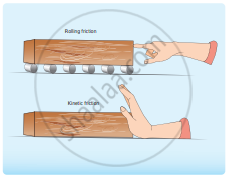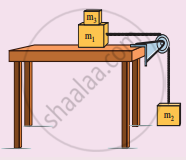Advertisements
Advertisements
प्रश्न
Briefly explain ‘rolling friction.'
उत्तर
The invention of the wheel plays a crucial role in human civilization. One of the important applications is suitcases with rolling on coasters. Rolling wheels makes it easier than carrying luggage. When an object moves on a surface, essentially it is sliding on it. But wheels move on the surface through rolling motion. In rolling motion when a wheel moves on a surface, the point of contact with the surface is always at rest. Since Rolling and kinetic friction, the point of contact is at rest, there is no relative motion between the wheel and surface.

Rolling and kinetic friction
Hence the frictional force is very less. At the same time, if an object moves without a wheel, there is a relative motion between the object and the surface. As a result, the frictional force is larger. This makes it difficult to move the object. The figure shows the difference between rolling and kinetic friction. Ideally in pure rolling, the motion of the point of contact with the surface should be at rest, but in practice, it is not so.
Due to the elastic nature of the surface at the point of contact, there will be some deformation on the object at this point on the wheel or surface as shown in the figure. Due to this deformation, there will be minimal friction between wheel and surface. It is called ‘rolling friction. In fact, rolling friction is much smaller than kinetic friction.
APPEARS IN
संबंधित प्रश्न
Explain various types of friction.
State the empirical laws of static and kinetic friction.
A long stick rests on the surface. A person standing 10 m away from the stick. With what minimum speed an object of mass 0.5 kg should he has thrown so that it hits the stick. (Assume the coefficient of kinetic friction is 0.7).
Two masses m1 and m2 are connected with a string passing over a frictionless pulley fixed at the comer of the table as shown in the figure. The coefficient of static friction of mass m1 with the table is µs Calculate the minimum mass m3 that may be placed on m1 to prevent it from sliding. Check if m1 = 15 kg, m2 = 10 kg, m3 = 25 and µs = 0.2.

Briefly explain the origin of friction. Show that in an inclined plane, the angle of friction is equal to the angle of repose.
A block of mass 20 kg is sliding on a surface is inclined at an angle of 45° with the horizontal. What will be the acceleration of the block if the coefficient of kinetic friction between the block and the surface is 0.7?
A 40 kg wooden crate is being pushed across a wooden floor with a force of 160 N. If µk = 0.3, the acceleration of the crate is ______ m/s2. (g = 10 m/s2}
Block A has a mass of 2 kg and block B has 20 kg. If the coefficient of kinetic friction between block B and the horizontal surface is 0.1, and B is accelerating towards the right with a = 2 m/s2, then the mass of the block C will be ______.
(g = 10 m/s2)

A chain of mass 'M' and length 'L' is put on a rough horizontal surface and is pulled by constant horizontal force 'F' as shown in the figure. The velocity of the chain as it turns completely ______.
(Coefficient of friction = μ)

A body starts from rest on a long inclined plane of slope 45°. The coefficient of friction between the body and the plane varies as µ = 0.3 x, where x is distance travelled down the plane. The body will have maximum speed (for g = 10 m/s2) when x = ______.
